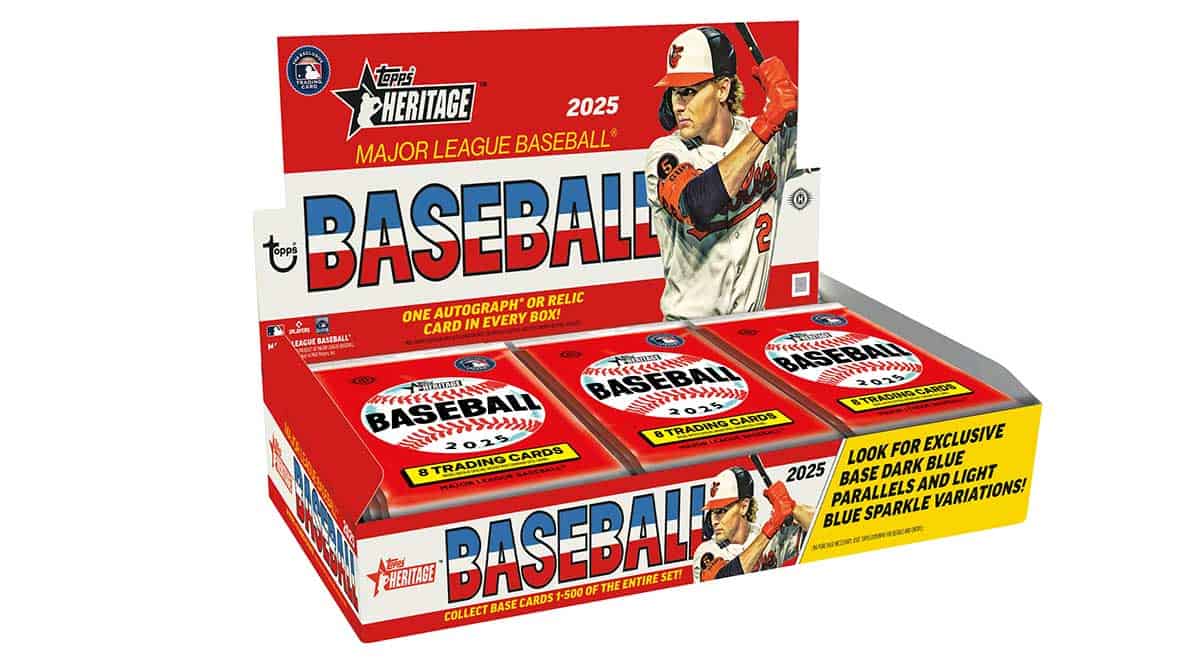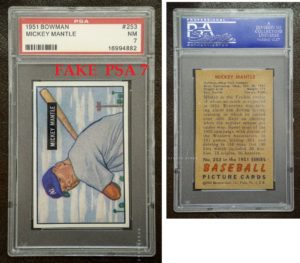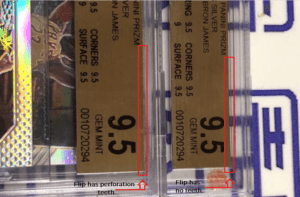-
 2021 Panini Prizm Baseball Cello Box
×
$69.991 × $69.99
2021 Panini Prizm Baseball Cello Box
×
$69.991 × $69.99


Authentication is one of the main reasons people slab their cards. So, in theory, when a card is placed in the slab of a respected grading company, we can be assured that it is real and has not been significantly altered. But, unfortunately, sometimes the slabs themselves are fake. So, how do we identify fake sports card slabs?
There are plenty of good reasons to get your card slabbed. The slabs protect the cards and help keep them in better shape for longer. Graded cards, especially PSA or BGS, fetch a much higher price in the market. For example, a raw Lebron rookie card sells for about $450 raw. But a graded PSA 10 recently went for $42,000.
Like anything else in life, unscrupulous characters become involved when there is a lot of money involved. They know that collectors tend to be more trusting of slabbed cards than their raw counterparts and take advantage of that fact.
There are fake slabs out there, and if you buy one, and when you buy one, you could be helping people commit fraud. You will also receive a pretty much worthless piece of plastic. So you better take care!

Slabs add a lot to card value and therefore can be worth faking (look for PSA graded lots on eBay).
The most common card sales nowadays are on eBay or social media platforms. These are good ways to move fake slabs because it is difficult for the buyer to examine the slabs in question before purchasing closely.
So, what elements do you need to check to be confident that your slab is genuine?
Grading companies make the label from unique material and put numbers on each label to make each identifiable genuine.
In 2017, PSA released the “Lighthouse Label” on the front of the slab. The label ‘lights up’ when rotated. That provides a noticeable beacon to allow users assurance that the slab in their hands is authentic. Some of the fake PSA “Lighthouse” part of the labels are printed directly onto the white label. Meanwhile, the real ones are glued onto the white part of the label, and the two types of material are pretty distinct.
It also has further authentication indicators. If you look at the back of the slab, another PSA logo is made of foil on the left. If you light it up with ultra-violet light, six smaller PSA logos are revealed. You can also make these out in regular light by moving the slab around.
Meanwhile, to the right, there is a scannable code that you can use with the PSA verification app to get details on your card. The info includes the certification number, grade, and population data.
Therefore, it is challenging to forge a post-2017 PSA slab successfully.
The problem is with older slabs, predating the introduction of the “Lighthouse Label.” To make matters worse, the older slabs were easier to pry open as well.

The lighthouse PSA flip has several layers of security to use to your advantage (picture from PSA).
But how can you identify some other fake PSA holders?
Some people won’t buy older PSA slabs because they are easier to fake. We wouldn’t go that far. However, if you do purchase pre-2017 slabs, do some homework first.
The slabs went through several iterations. In fact, there have been ten changes of the PSA’ flip,’ and the slab itself has changed as well. Therefore, do not be alarmed if an older slab looks a bit different from what you expected. But make sure that the format you see corresponds to the flips PSA was making in that time period.
Luckily, some of the slabs are poorly forged. In some examples, the label doesn’t really fit the top section of the card. Loose-fitting is a definite indication of a forgery.
For example, in a PSA slab, the red borders of the label should completely fill up the section, with absolutely no space left open.
You can check the details on any card by going to the Cert Verification section on the PSA website. Put in the certificate number and see if it matches. Is it the same card? Have unscrupulous actors owned it? Again, you can get the information you need on the website.
Unfortunately, this will only help you detect some fake slabs. The cert is taken from a real slab in many cases, but another card was placed within the holder. In those cases, looking up cert verification is of limited use.
Still, many of the listings include information on previous auctions. In those cases, you can see a picture of the card and compare the two.
Some ripped-off users report that once they received the slab, it had visible signs of tampering on it. These signs can include cracks or actual gaps in parts of the slab. If you see this, it is a clear red flag.
When scammers have cracked open the slab to replace the card inside, there are some telltale signs. One of those is discoloring which looks like there is frosting on the outside edges of the slab. It is visually similar to what you would expect if you removed the slab from the freezer. Frosting occurs when the sonic weld on the slab was punctured.

Fake PSA slabs often show this type of frosting (picture taken from Blowout Forums).
Sometimes the scammer will put one flip on top of the other to throw off the buyer. In these cases, the old flip is often visible. Or they will place a fake sticker on top of a real PSA flip to keep the hologram or bar code. However, you need to hold it up to a light to see.
We have focused on PSA slabs because they are the premier grading company. However, because they do not have the same level of security measures, there seem to be more fake BGS slabs out there than PSA ones.
The most common forms of fake BGS slabs are identifiable through patent registration. Each BGS slab has a registered patent number on the bottom. That number is PAT.6295750 B1. Take note of the spaces and the dot. Many of the fake ones either do not have the patent number at all, or they include the wrong number. Often the spaces are off, or the dot is not there.
Other signs found on common fake BGS slabs include the incorrect font and the plaque missing the perforated edges that usually come on their slabs.

The fake BGS flips usually do not have perforated edges (picture taken from Blowout Forums).
Some cards are often targeted for fakes. It is no surprise that some of the most coveted and tampered with cards are also the most likely to be found in a fake slab. Here is a list of some of the most tampered with and counterfeited slabs and cards:
Breaking a slab and then reconstructing it isn’t easy and time-consuming. Therefore, when you buy lower-end slabs, it is improbable that anyone bothered to fake them. However, any high-end purchase is worth checking and double-checking. So please do your homework, look up more expensive cards before you buy, and be on the lookout for any of the telltale signs we identified.
What PSA's price increase means for grading + Bowman 2025 Baseball and more

32 Spot Random Team 2024 NFL Mosaic Mega 8 Box Break

32 Spot Random Team 2024 NFL Mosaic Blaster 10 Box Break.

Sealed Blaster Box of 2022 Topps MLB Baseball Update Series.

Sealed box of 2019 Topps MLB Baseball Series 2 Hobby Box. 1 autograph or relic card guaranteed. Great rookie class.

Sealed Box of 2021 Panini Prizm Baseball Cello. 12 packs per box, 18 cards per pack.

© Copyright 2025 - All rights reserved Cardlines.com / Media Techs LLC - Sports Card News, Reviews, Releases and BREAKS - #thehobby.
Important: When you click on links to various merchants on this site and make a purchase, this can result in this site earning a commission. Affiliate programs and affiliations include, but are not limited to, the eBay Partner Network.